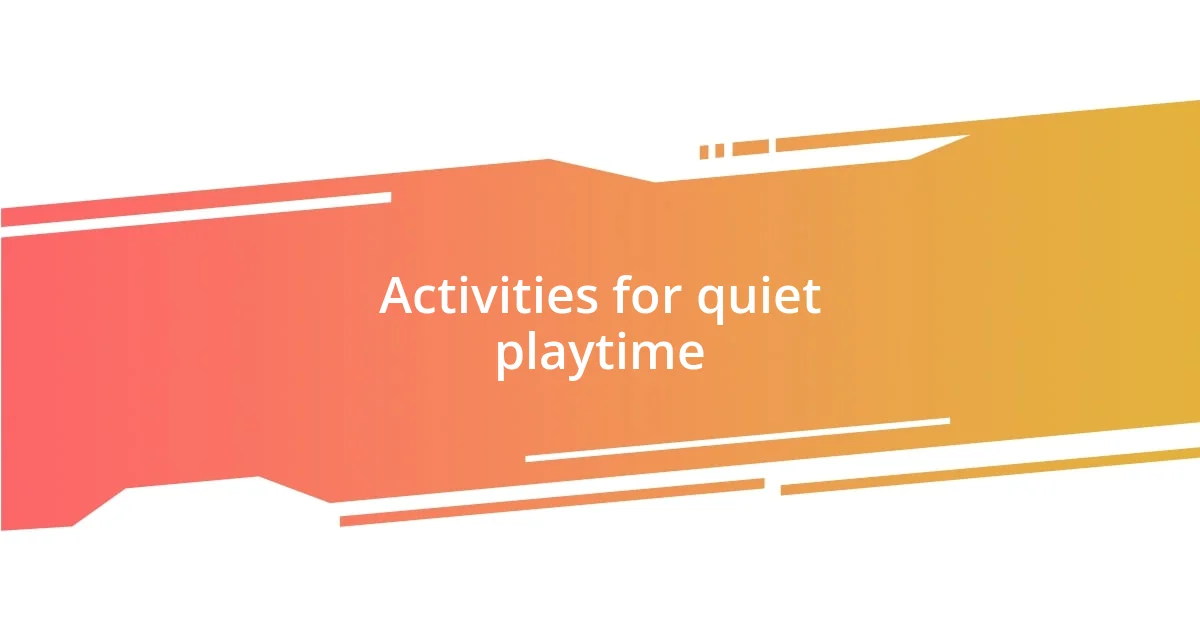Key takeaways:
- Quiet playtime fosters creativity, self-regulation, and emotional development by allowing children to explore interests at their own pace.
- Activities like reading, puzzles, and art enhance concentration, problem-solving skills, and cognitive development, making playtime a significant educational tool.
- Creating an organized, calming space for quiet play encourages deeper engagement and strengthens social skills, emotional expression, and imaginative exploration.

What is quiet playtime
Quiet playtime is a delightful concept where children engage in activities that promote creativity and focus in a serene environment. I recall one rainy afternoon when my niece set up a cozy corner with her favorite books and a few colorful crayons. Watching her lose herself in that moment, completely absorbed in her own world, made me realize how powerful quiet play can be for fostering imagination.
In essence, quiet playtime allows children to explore their interests at their own pace. Have you ever watched a child build a fort with nothing but cushions? That simple act, filled with concentration and joy, is a perfect example of how quiet play nurtures problem-solving skills and encourages independent thinking. I’ve seen kids come up with the most intricate stories just from a quiet moment spent in their own little realm.
This special time not only refreshes a child’s mind but also serves as a valuable opportunity for emotional development. I remember observing a small group of children playing quietly, sharing soft giggles as they created a pretend kitchen. It was heartwarming to see them interact with empathy and creativity, reinforcing bonds through collective imagination. Isn’t it intriguing how quiet playtime can cultivate such rich social skills, all while enveloped in tranquility?

Benefits of quiet playtime
Quiet playtime provides a myriad of benefits that extend far beyond mere entertainment. One of the most significant advantages is the promotion of self-regulation. I’ve noticed that when children engage in quiet activities, like doing puzzles or coloring, they learn how to manage their emotions and impulses. For instance, I once saw my friend’s son, frustrated by a challenging puzzle. Instead of giving up, he took a deep breath and calmed down, ultimately persevering to complete it. That moment stood out to me as a testament to how quiet playtime can instill resilience.
Moreover, quiet playtime fosters incredible concentration skills. I remember a day at a local art fair where my daughter lost herself in painting a still life. Surrounded by the chatter and excitement of the event, she remained focused for an entire hour. This kind of immersive experience not only enhances attention spans but also deepens creative thought. That focused, peaceful state allows kids to think critically and innovate, skills that will serve them well in the future.
Lastly, this serene playtime significantly enhances cognitive development. When children engage in quiet solitary activities, they often experiment with concepts they learn in school. One afternoon, I watched my nephew use blocks to build a structure while silently pondering the balance and symmetry of his design. Those moments of quiet exploration can lead to significant learning breakthroughs. It’s fascinating to see how play intertwines so beautifully with education when given the space to unfold quietly.
| Benefit | Description |
|---|---|
| Self-regulation | Quiet play helps children manage emotions and impulses more effectively. |
| Concentration skills | Engaging in quiet activities enhances children’s focus and critical thinking. |
| Cognitive development | Quiet play allows for the exploration and experimentation of concepts learned in school. |

Activities for quiet playtime
Engaging in quiet playtime can take many forms, and each activity offers its own unique benefits. I remember when my daughter discovered the joy of building with small wooden blocks. She would spend hours meticulously stacking them, completely in her zone. It was mesmerizing to see how one moment she was constructing towers, and the next, she was envisioning them as spaceships soaring through an imaginary universe. This kind of immersive play not only fosters creativity but also helps enhance fine motor skills.
Here are some activities that make for wonderful quiet playtime:
- Reading: Losing oneself in a book transports children to different worlds, fostering their imagination and literacy skills.
- Puzzles: These encourage problem-solving and cognitive understanding, much like the one my friend’s son tackled with determination.
- Art projects: Drawing, coloring, or painting allows children to express feelings and thoughts visually.
- Building blocks: As I’ve seen firsthand, the act of construction promotes creativity and spatial awareness.
- Nature exploration: A quiet walk collecting leaves or stones can spark curiosity about the natural world.
- Playdough: Manipulating playdough strengthens hand muscles and encourages creative expression.
Each of these activities cultivates a child’s mind while enveloping them in a peaceful atmosphere. I consistently find myself inspired by how such simple moments can yield profound effects on a child’s development.

Creating a quiet playtime space
Creating a quiet playtime space is all about fostering an environment that encourages calmness and creativity. When I set up a designated corner in our living room with a cozy rug, soft cushions, and warm lighting, I noticed how much my kids gravitated toward that space. It’s almost as if the physical space itself becomes a cue for them to engage in more reflective, peaceful play rather than the typical chaotic energy we’ve come to expect.
I also find that the sensory elements play a significant role in creating this atmosphere. For instance, I love incorporating calming sounds, like gentle nature playlists or nature sounds, which immediately set a serene tone. Once, during a stormy afternoon, we turned on soft rain sounds while my daughter settled down with her sketchbook. The combination of sound and cozy surroundings transformed the mood, allowing her to unleash her creativity as she drew the vibrant world outside her window.
Lastly, I believe that decluttering is essential for a quiet playtime space. When toys are organized and easily accessible, it becomes simpler for kids to choose what resonates with them. I remember a day when I helped my son sort his toys into bins. That single act seemed to open doors for him to discover games and activities he hadn’t touched in months. Isn’t it amazing how a little organization can lead to such profound exploration and engagement? In our home, creating a serene space is not just a physical act; it’s a gateway to meaningful play that nurtures their growth.

Engaging children in quiet play
Engaging children in quiet play can be a delightful experience that nurtures their imaginations and emotional well-being. I recall a rainy afternoon when my son sat at the dining table, absorbed in a gentle coloring book I had picked up at the local bookstore. Watching him choose colors and create his own little masterpieces, I felt a wave of peace wash over me. Isn’t it fascinating how a simple art project can not only entertain kids but also help them express their feelings in such a vivid way?
When it comes to quiet play, I’ve found that being present with my children makes a world of difference. One evening, we decided to build a blanket fort together, and as we nestled inside with flashlights and books, I felt an unexpected connection forming. The quiet atmosphere allowed us to share stories and giggles without the usual distractions. Moments like these show that engaging in quiet play can actually deepen our relationships while providing a calm refuge from life’s busyness.
I also think that incorporating themed quiet play scenarios adds an extra layer of excitement. For example, I remember setting up a small “library” at home, complete with tiny chairs and a little book nook. The joy in my daughter’s eyes when she walked into that space was priceless. She transformed into the librarian, checking out books while narrating each story. It’s incredible how a simple setup can spark role-playing, turning quiet time into a vibrant experience filled with imagination and exploration. Have you ever noticed how an engaging environment can elevate a child’s play?

Observing child development through play
Watching my children play quietly, I often marvel at their developing skills. One evening, I noticed my youngest quietly stacking blocks, focused and deeply engaged. It struck me how this seemingly simple act was not just play; it was a foundation for learning about balance, coordination, and even patience. Doesn’t it amaze you how much growth can occur when we step back and allow children the space to explore on their terms?
As I observe their interactions, I see social skills blossoming during quiet games. The other day, my kids decided to play “store” with their toys. They took turns being the seller and the customer, negotiating prices and trading items. It was beautifully informative to witness their communication evolve—those moments of collaboration strengthened their understanding of sharing and empathy. Isn’t it remarkable how quiet playtime can become a powerful teacher?
I’ve also realized that the solitary moments of play contribute to a child’s emotional growth. When I found my daughter curled up with her stuffed animals, narrating an imaginary adventure, I felt a swell of gratitude. In those quiet moments, she practiced storytelling and self-expression. It made me wonder: how often do we underestimate the depth of creativity that emerges from silence? Every time they engage in thoughtful play, I’m reminded of how it shapes not just their minds but their hearts as well.















